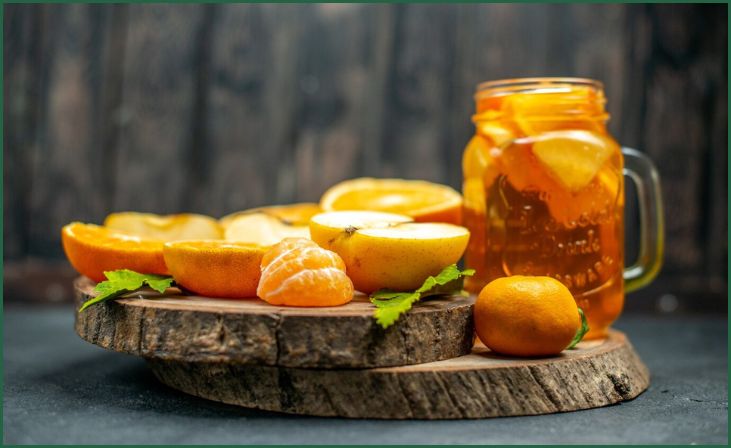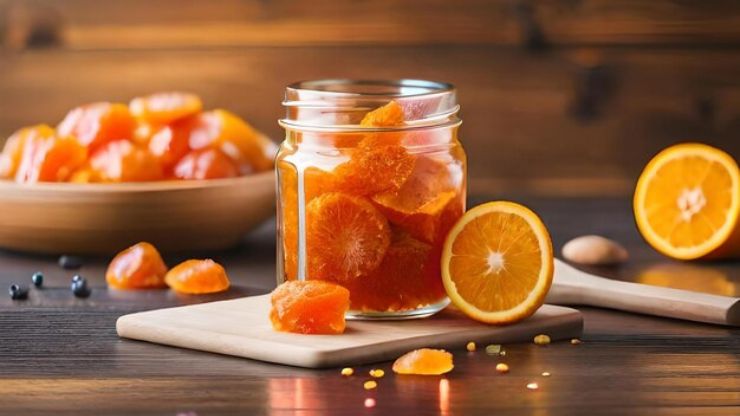Embark on a flavorful journey into the zestful world of fermented oranges! If the idea of transforming ordinary citrus into a tangy delight intrigues you, you’ve arrived at the perfect guide. In this comprehensive exploration, we’ll unravel the steps that metamorphose humble oranges into a probiotic-rich treat, promising to tantalize your taste buds and foster optimal gut health.
The process begins by selecting fresh, preferably organic oranges, which are then expertly sliced and layered in a glass jar. A carefully crafted brine, composed of non-chlorinated water and sea salt, envelops the citrus slices, initiating the fermentation alchemy. Weights or fermentation stones ensure the oranges remain submerged, while a patiently monitored fermentation period of 1-2 weeks allows the flavors to mature.
The result is a culinary masterpiece—fermented oranges that not only delight the palate but also infuse your diet with gut-loving probiotics. Get ready to savor the extraordinary and savor the health benefits of your homemade fermented oranges. Cheers to culinary creativity and well-being!
Table of Contents
ToggleHow To Make Fermented Oranges

Making fermented oranges is a delightful process that yields a tangy and probiotic-rich treat. Here’s a step-by-step guide to help you embark on this flavorful journey:
Ingredients:
- Oranges (any variety, preferably organic)
- Non-chlorinated water
- Sea salt or Himalayan salt
- Optional: Spices like cinnamon sticks or cloves for added flavor
Also Read: Fermenting Weight
Equipment:
- Glass jars with airtight lids
- Knife and cutting board
- Mixing bowl
- Weights or fermentation stones
- Clean cloth or coffee filter
Instructions:
- Selecting Oranges:
- Choose fresh, organic oranges to ensure the best flavor and nutritional content.
- Preparing Oranges:
- Wash the oranges thoroughly and slice them into wedges or rounds. You can keep the peel on for added flavor and texture.
- Creating the Brine:
- In a mixing bowl, dissolve 1-2 tablespoons of sea salt in a quart of non-chlorinated water. Adjust the salt quantity to your taste preference.
- Layering the Jar:
- Place a few orange slices at the bottom of the glass jar, then pour a small amount of the brine over them. Repeat this layering process until the jar is nearly full, leaving about an inch of space at the top.
- Pressing and Weighing:
- Place weights or fermentation stones on top of the oranges to ensure they stay submerged in the brine. This helps prevent mold formation. Ensure that the oranges are fully immersed in the brine.
- Covering the Jar:
- Cover the jar with a clean cloth or coffee filter, securing it with a rubber band or the jar’s lid (loosely closed). This allows gases to escape during fermentation while keeping out dust and contaminants.
- Fermentation Process:
- Store the jar in a cool, dark place for about 1-2 weeks. Check the oranges periodically to ensure they remain submerged and taste the oranges to monitor the fermentation progress. The longer the fermentation, the tangier the flavor.
- Taste Testing:
- Once the desired level of tanginess is achieved, remove the weights and transfer the jar to the refrigerator to slow down the fermentation process.
- Enjoying Fermented Oranges:
- Fermented oranges can be enjoyed on their own, added to salads, or used as a unique topping for desserts. The probiotics that are made during fermentation help keep your gut healthy.
- Storing:
- Keep the fermented oranges in the refrigerator, where they can last for several weeks.
Also Read: Fermenting in Hot Weather
Experiment with different spices or even mix in other citrus fruits to create your signature fermented citrus blend. Cheers to your homemade probiotic-packed fermented oranges!
Health benefits Of Fermented Oranges

Fermented oranges offer a myriad of health benefits, making them a delightful addition to your diet. Here are a few of the most important pros:
Probiotic Powerhouse
Fermentation introduces beneficial bacteria to the oranges, transforming them into a rich source of probiotics. These friendly microorganisms support a healthy gut microbiome, enhancing digestion and nutrient absorption.
Increased Nutrient Bioavailability
The fermentation process breaks down compounds in oranges, making essential nutrients more accessible to the body. This increased bioavailability ensures you reap the maximum nutritional benefits from each citrus bite.
Don't just scroll, subscribe!
BuzzTrail's unique web-stories are the cure for boredom you've been waiting for.
Gut Health Support
Probiotics derived from fermented oranges contribute to a balanced gut flora. A healthy gut has been linked to improved immune function, better mood, and even a reduced risk of certain diseases.
Vitamin Boost
Oranges are naturally rich in vitamin C, and fermentation can enhance this content. Vitamin C is renowned for its immune-boosting properties, promoting overall health and well-being.
Digestive Comfort
The probiotics in fermented oranges may help alleviate digestive discomfort by promoting the balance of gut bacteria, reducing symptoms like bloating and indigestion.
Antioxidant Action
Oranges are packed with antioxidants, and fermentation may enhance their antioxidant activity. These compounds help combat oxidative stress, supporting cellular health and potentially reducing the risk of chronic diseases.
Also Read: How Long Can You Leave Your Fermented Foods?
Incorporating fermented oranges into your diet provides not only a burst of unique flavor but also a nutritional powerhouse that contributes to your overall well-being.
Conclusion
Embarking on the journey to craft fermented oranges invites you to relish the extraordinary transformation of citrus into a uniquely delightful creation. Embrace the joy of experimentation with various flavors, infusing your concoction with personal flair.
Share the pleasures of fermentation with others, turning a simple kitchen venture into a shared culinary adventure. Beyond the delectable taste, savor the health benefits bestowed by this straightforward yet rewarding process, amplifying the nutritional value of the oranges.
Cheers to your newfound expertise in the art of fermenting oranges—a journey that promises not only a feast for the taste buds but also a celebration of creativity and well-being!
FAQs
Why should I ferment oranges?
Why should I ferment oranges?
Fermenting oranges not only enhances their flavor but also unlocks nutritional benefits. The fermentation process increases the bioavailability of nutrients and introduces probiotics, promoting a healthy gut microbiome.
Can I use any type of oranges for fermentation?
Can I use any type of oranges for fermentation?
Absolutely! Whether you prefer Valencia, Navel, or blood oranges, all varieties can be fermented. Just ensure they are fresh, preferably organic, to maximize flavor and nutritional content.

